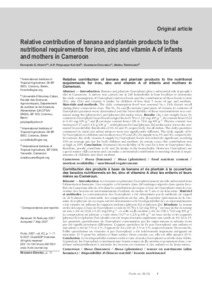| dc.contributor.author | Honfo, F.G. |
| dc.contributor.author | Kayodé, A.P. |
| dc.contributor.author | Coulibaly, O. |
| dc.contributor.author | Tenkouano, A. |
| dc.date.accessioned | 2019-12-04T11:19:28Z |
| dc.date.available | 2019-12-04T11:19:28Z |
| dc.date.issued | 2007 |
| dc.identifier.citation | Honfo, F.G., Kayodé, A.P., Coulibaly, O. & Tenkouano, A. (2007). Relative contribution of banana and plantain products to the nutritional requirements for iron, zinc and vitamin A of infants and mothers in Cameroon. Fruits, 62(5), 1-11. |
| dc.identifier.uri | https://hdl.handle.net/20.500.12478/3472 |
| dc.description.abstract | Banana and plantain (ban+plant) play a substantial role in people’s diet in Cameroon. A survey was carried out in 240 households in four localities to determine the daily consumption of (ban+plant)-derived foods and the contribution of these foods to iron (Fe), zinc (Zn) and vitamin A intake by children of less than 5 years of age and mothers. Materials and methods. The daily consumption level was assessed by a 24-h dietary recall during three consecutive days. The Fe, Zn and β-carotene (precursor of vitamin A) contents of (ban+plant) products were determined and the bioavailability of these micronutrients was estimated using the [phytate:Fe] and [phytate:Zn] molar ratios. Results. On a dry-weight basis, Fe content in (ban+plant)-based foods ranged from (0.78 to 1.32) mg•100 g–1; Zn content from (0.22 to 0.41) mg•100 g–1 and β-carotene content from (336 to 724) µg•100 g–1. Phytate content was between (0.17 and 1.23) g•100 g–1, with [phytate:Fe] and [phytate:Zn] molar ratios above the estimated bioavailability thresholds of 10–14 and 15, respectively, for all dishes. The daily quantities consumed by rural and urban subjects were not significantly different. The daily supply of Fe by (ban+plant) to children and mothers was 5% and 2%; Zn supply was 3% and 4%, respectively. In contrast, the daily vitamin A supply by (ban+plant) foods was relatively significant, reaching 13% on average per day for both children and mothers. In certain cases, this contribution was as high as 20%. Conclusion. Estimated bioavailability of Fe and Zn is low in (ban+plant) that, therefore, poorly contribute to Fe and Zn intake in the households. However, (ban+plant) are a good source of β-carotene and can make a substantial contribution to meeting vitamin A requirements of children and their mothers. |
| dc.language.iso | en |
| dc.subject | Musa (Bananas) |
| dc.subject | Nutritional Requirements |
| dc.subject | Musa (Plantains) |
| dc.subject | Food Nutrient Content |
| dc.subject | Nutrient Availability |
| dc.subject | Bioavailability |
| dc.subject | Β-Carotene |
| dc.subject | Households |
| dc.title | Relative contribution of banana and plantain products to the nutritional requirements for iron, zinc and vitamin A of infants and mothers in Cameroon |
| dc.type | Journal Article |
| dc.description.version | Peer Review |
| cg.contributor.affiliation | International Institute of Tropical Agriculture |
| cg.contributor.affiliation | Université d'Abomey Calavi |
| cg.coverage.region | Africa |
| cg.coverage.region | West Africa |
| cg.coverage.region | Central Africa |
| cg.coverage.country | Benin |
| cg.coverage.country | Cameroon |
| cg.isijournal | ISI Journal |
| cg.authorship.types | CGIAR and developing country institute |
| cg.iitasubject | Nutrition |
| cg.iitasubject | Banana |
| cg.iitasubject | Genetic Improvement |
| cg.iitasubject | Pests Of Plants |
| cg.iitasubject | Plant Diseases |
| cg.iitasubject | Plant Production |
| cg.iitasubject | Food Security |
| cg.iitasubject | Handling, Transport, Storage And Protection Of Agricultural Products |
| cg.iitasubject | Plant Breeding |
| cg.iitasubject | Plant Genetic Resources |
| cg.iitasubject | Livelihoods |
| cg.iitasubject | Disease Control |
| cg.accessibilitystatus | Open Access |
| local.dspaceid | 95443 |
| cg.identifier.doi | https://doi.org/10.1051/fruits:2007023 |

